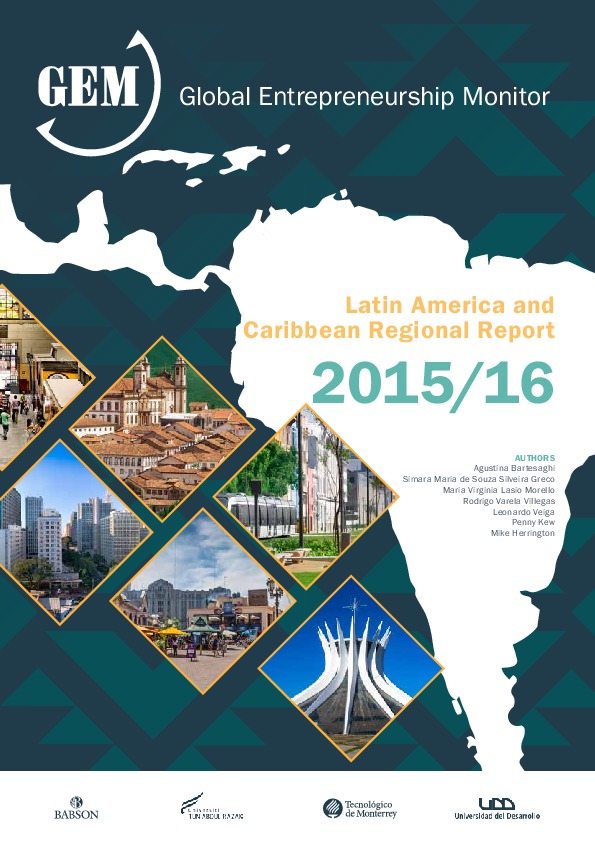Policy makers in Latin America and the Caribbean (LAC) must focus on boosting innovation and entrepreneurship in order to sustain the development gains of recent years, according to a new GEM report on the state of entrepreneurship in the region.
According to Mike Herrington, Executive Director of GEM and Leonardo Veiga (GEM Uruguay), one of the authors, while the region at the turn of the century recorded good indicators of economic performance, the past five years have seen a continuous decline in growth, due to an external environment adverse to commodity exporters, which is cause for concern.
“More needs to be done to support entrepreneurship in the region. The region has a very high percentage of people who want to start businesses – on average, about two-thirds of people in the region report positive social attitudes towards entrepreneurship and about one fifth of the adult population is engaged in early-stage entrepreneurial activity, which is higher than that of the other geographical groupings, except Africa – but to unlock the potential that these numbers represent, entrepreneurs need a more enabling environment that explicitly allows them to emerge, compete and innovate,” said Rodrigo Varela (GEM Colombia), one of the authors of the report.
Twelve countries: Argentina, Barbados, Brazil, Chile, Colombia, Ecuador, Guatemala, Mexico, Panama, Peru, Puerto Rico and Uruguay, participated in the 2015 survey, representing 82% of the region’s population and 88% of its GDP.
The survey highlighted several areas that need attention in the entrepreneurial landscape. Key among these is the fact that there is a lot of leakage in the entrepreneurial pipeline with many potential entrepreneurs quitting before they even get started. “There was a 26% drop off between potential entrepreneurs – those who report positive attitudes toward entrepreneurship (59%) and intentional entrepreneurs – those who report they are going to start a business (33%) – and a further drop off between intentional and nascent entrepreneurs of around 20 percentage points. In addition, LAC shows the second-highest regional business discontinuance rate globally,” said Varela.
The survey also revealed that the LAC countries are facing barriers to innovation which threaten growth prospects. On the Global Innovation Index, no LAC country falls within the best performing 25% of the rated countries, while four fall within the worst-performing group. But the average, in terms of level of innovation for the LAC region (26.5%) is higher than the average for similar economies (classified as efficiency-driven economies) – and also higher than the averages for Africa, Asia and Oceania.
“To ensure long-term growth, increasing the number of dynamic, innovation-based enterprises – which survive – is going to be crucial,” said Simara Greco (GEM Brazil).
Virginia Lasio (GEM Ecuador) indicated: “There is work to be done here. The GEM research indicates that the key areas in need of informed policies to support entrepreneurship and innovation are entrepreneurial finance; government policies; education; institutional, political and social context; and access to information. More investment in research and development (R&D) could also help”
"Compared to innovation powerhouse China, there is little R&D in LAC countries. Yet there’s a clear link between R&D investment, notably by the private sector, and growth,” says Herrington.
There are strong signs that the region has massive potential, he added. ‘Leapfrogging’, for example, has been noted as a common phenomenon. Cost-effective digital marketing, products and services are taking flight. Fast Company has reported on the ten most innovative initiatives in Latin America: low-cost food vending machines, digital banking, a homecoming campaign for lost Colombian guerrillas, a small business support network, and a post-tsunami rapid reconstruction plan. The World Economic Forum has reported on disruptive innovation taking hold in the region, predicting greater financial and technological inclusion. In September 2016, it was reported that household internet connections in LAC countries had doubled.
“With the right interventions and policy choices, GEM believes that, while the work will be hard, there is reason to be optimistic about the future growth in the region,” concluded Herrington.


